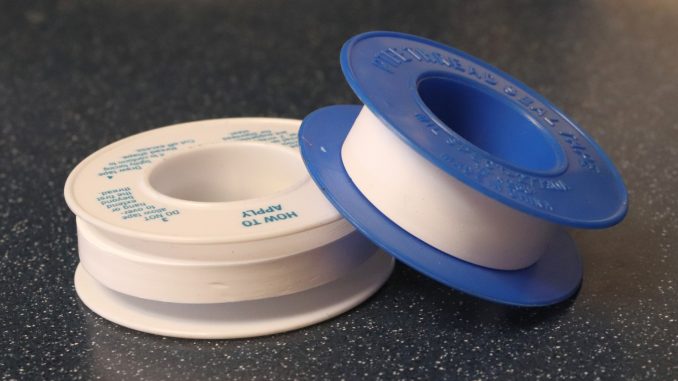
Teflon tape or PTFE Plumber’s Tape? It is an age-old question that has been asked by countless people through the years who have found themselves needing to carry out thread sealing or bind pipework parts tightly together.
They know that they need a tape to carry out the job, they just don’t know which one to use. Is Teflon or PTFE better? In fact, what even is the difference?
The answer to that second question – both questions in fact – is that there is no difference. Teflon Tape and PTFE tape are exactly the same product made from exactly the same material. One is the name of the chemical which the tape is made from, the other is the brand name of said polymer.
PTFE Tape
PTFE is the shortened name of the chemical polytetrafluoroethylene. Polytetrafluoroethylene was accidentally discovered in 1938 by a chemist called Roy J. Plunkett, who was working on the development of a new refrigerant for the DuPont company.
Plunkett was using a bottle which had been emptied of TFE gas but was not weighing as empty. When he cut into the bottle to find out what was causing the weight, he discovered a slippery, waxy material – PTFE.
Studies of PTFE revealed that it had a host of useful properties. It had a high melting point, was water resistant, could not be damaged by most chemicals and solvents, was fully flexible and could be applied to a variety of surfaces.
All of which made it perfect as a thread sealant tape. PTFE Tape became known as Plumber’s Tape because virtually every plumber keeps a roll of it in their toolbox, but it can also be used on gas, oxygen and other fuel lines.
Teflon Tape
In 1945, DuPont patented their newly discovered chemical as Teflon. It was first introduced to the public in 1960, when the non-stick properties of Teflon made it the perfect material for coating frying pans and other cookware.
Teflon then is simply the brand name of PTFE produced by DuPont, in much the same way as Sellotape is a brand of sticky tape and Hoover a type of vacuum cleaner. Teflon has just become synonymous with PTFE tape to the point where it almost is the chemical.
Which is ironic as PTFE tape is no longer manufactured by the current holder of the Teflon trademark, Chemours – which means that Teflon Tape as a product does not exist anymore.
So perhaps the answer to the question of which is better, Teflon Tape or PTFE Tape is actually quite simple – it has to be PTFE Tape as Teflon Tape isn’t a purchasable product.
Self-fusing Silicone Tape
Whether you decide to call it PTFE tape, plumber’s tape or even thread sealant tape, one thing that you should not do is confuse it with pipe repair tape, which is a different product altogether.
PTFE tape helps produce watertight seals and bind parts together, but it will not effectively fix a cracked or damaged pipe. Plumber’s tape does not have the ability to glue effectively around leaking pipes and most repairs carried out with it are temporary at best.
Instead, you need self-fusing silicone tape. This type of pipe repair tape will bond into a solid rubber band when wrapped around a leaking pipe, providing maximum pressure over a leak by stretching to 300% its length.
This is particularly useful when it comes to sealing a live leak where water flow cannot be turned off. Silicone tape can resist pressure of up to 30bar, temperatures in excess of 200ºC and various chemicals.
People often look at the price differential between PTFE take and silicone tape and decide to go for the former, not aware of the fact that the quality of their pipe repair will be significantly lower.
For fixing a leaking pipe, there is only one solution – pipe repair tape. And there are no questions to be had over what it should be called, either.

Leave a Reply